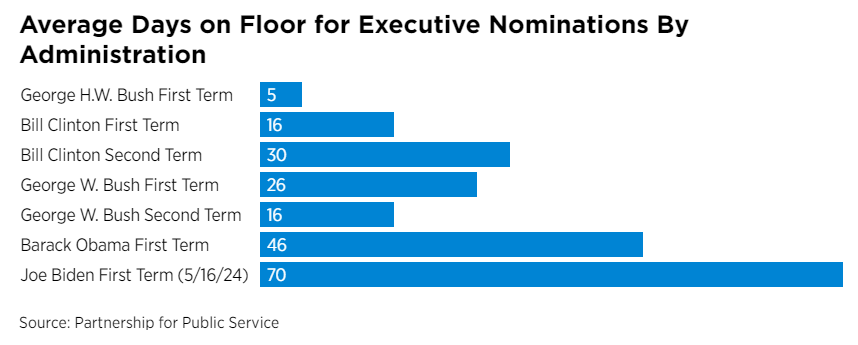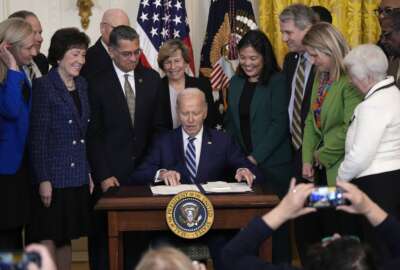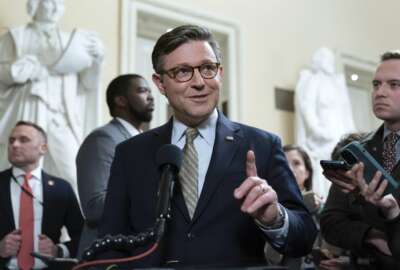Amid growing delays, Partnership calls for reforms to Senate confirmation process
During the Biden administration, confirming political nominees took an average of 121 days in committee, plus another 70 days on the Senate floor.
As President-elect Donald Trump continues naming his picks for key positions in his second term, a good government organization is warning that growing delays in the Senate confirmation process will make the path to permanent positions even more cumbersome.
The time it takes to confirm presidential nominees has grown significantly over time and is now longer than ever. According to new data from the Partnership for Public Service, President Joe Biden’s nominees took three times longer to confirm than nominees during the Reagan administration. During the Biden administration, confirming political nominees took an average of 121 days in committee, plus another 70 days on the Senate floor.
“The growth in Senate floor delays during the Biden administration is most striking, where Biden nominees spent 15 times longer before being confirmed compared with nominations in the George H.W. Bush administration,” the Partnership wrote in a new report, published Wednesday.
Jenny Mattingley, the Partnership’s vice president of government affairs, said the worsening delays over the last several administrations make it “very likely” that Trump would experience a continuation of that trend, facing even longer wait times for confirming political appointees. If the current trend continues, the Partnership estimated that the Trump administration would face a 25.6% average increase in confirmation delays, and an overall 240-day process.

Despite the delays, the vast majority of Biden’s nominees were eventually confirmed, and the Partnership’s research found that the delays mainly arose due to limited time on the Senate’s calendar for voting on nominations. But more broadly, the “broken” Senate confirmation also strains federal agencies, Mattingley said.
“While a president can install temporary, ‘acting’ leadership to fill these gaps, these officials cannot fully replace confirmed officials. Acting officials may be skilled professionals — often they are drawn from the most well-respected ranks of career officials, especially at the start of an administration — but they are not perceived by those around them as having the full authority of the confirmed appointee, and they do not view themselves as having the right to make decisions with long-term impact,” Mattingley said in an email to Federal News Network. “Excessive reliance on acting officials can invite legal challenges and raise questions about who is accountable to Congress and the public for performance of duties.”
Currently, a sitting president is expected to fill about 4,000 political positions, more than 1,200 of which require Senate confirmation. Over time, the Partnership said the number of positions requiring confirmation “continues to balloon,” exacerbating the Senate’s time and resource challenges.
At the same time, the Partnership’s new report presented various solutions to try to move the needle in the opposite direction.
“The relatively steep increase in floor delays indicates an important area to review for reform,” the Partnership wrote.
To move toward a solution, the Partnership recommended starting by reducing the number of positions that need Senate confirmation in the first place. But to effectively begin making reforms, the organization said it’s important to “pinpoint” the areas where delays are most prominent, and where Senate confirmation may not be necessary.
“The most straightforward way to decrease confirmation delays is to reduce the number of political appointees subject to Senate confirmation, with a focus on categories such as non-controversial boards and commissions,” the Partnership wrote.
Mattingley also recommended targeting federal positions that are working directly under multiple layers of other already Senate-confirmed positions. For example, she noted that the State Department has 26 positions requiring Senate confirmation that are four levels below the top confirmed leadership — and the Defense Department has 17 positions situated five levels below the top confirmed leadership, all of which still require Senate confirmation.
Congress should “start with the presumption that positions at the assistant secretary level or below — who typically report to multiple layers of Senate-confirmed officials — be presidential appointees but not subject to confirmation,” Mattingley said.
Additionally, for positions that are “chronically vacant” across government, Mattingley said the Senate should consider if any of those roles could be converted to non-confirmed positions, career federal jobs — or even eliminated. Technical, management and operational roles could also be good candidates for either removing the Senate confirmation requirement or converting to career positions, Mattingley said.
“Chief financial officers also should be candidates for these changes,” Mattingley said. “Their duties provide consistent, apolitical services that involve long-term financial planning and technical expertise.”
Beyond reducing the overall number of confirmations, the Partnership noted several situations where it may also be possible to expedite the Senate’s procedures. For example, the Senate could bundle together multiple nominations for a final vote. There are also opportunities for streamlining paperwork, and helping nominees better understand the process to lower the chances of delays.
Without improvements, Mattingley said the persistent vacancies will slow agencies’ decision making and strategic planning, negatively affect employee morale, and put other leadership decisions on hold.
Copyright © 2025 Federal News Network. All rights reserved. This website is not intended for users located within the European Economic Area.
Drew Friedman is a workforce, pay and benefits reporter for Federal News Network.
Follow @dfriedmanWFED






